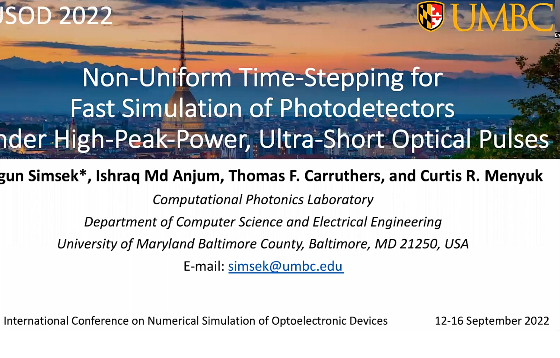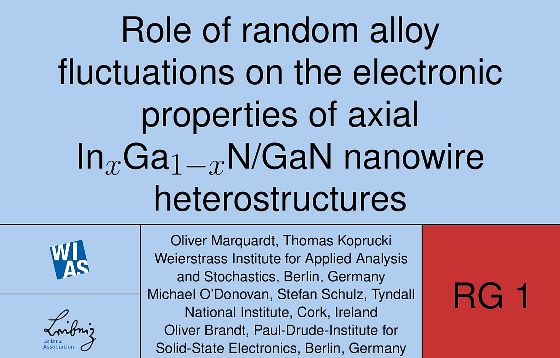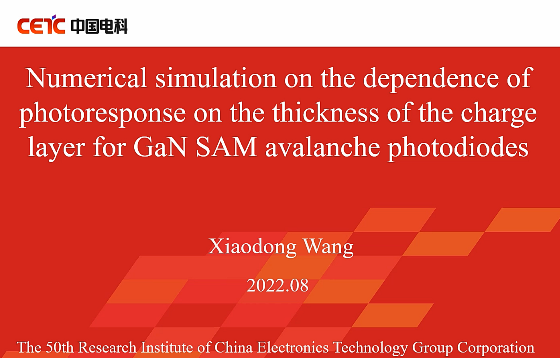


We numerically studied stimulated Brillouin scattering processes up to the 5th order is microcavities with various realistic diameters and Q-factors made of standard telecommunication fibres. Pump power thresholds were simulated for different parameters of the system. The larger the microcavity and lower Q-factors, the higher pump power thresholds are. It is also shown that thresholds […]
D01 – Non-Uniform Time-Stepping For Fast Simulation of Photodetectors Under High-Peak-Power, Ultra-Short Optical Pulses
A novel non-uniform time-stepping procedure is developed to reduce the memory usage and simulation time—by two orders of magnitude—of photodetectors when detecting high-peak-power, ultra-short optical pulses. The proposed procedure can be used in other marching-on-in-time solvers to achieve the same for the simulations dealing with ultra-short pulses.
P22 – Dynamics of colliding Bragg solitons in a dual-core system with separated grating and cubic-quintic nonlinearity
We investigate the collisions of counterpropagating Bragg solitons in a dual-core optical coupler where one core has cubic-quintic nonlinearity and is coupled to another linear core equipped with a uniform Bragg grating. The outcomes of the collisions are diverse and exhibit rich dynamics.
LED06 – Ray Tracing Simulation of a GaN-based integrated LED-Photodetector System
An optical sensor system consisting of a pair of GaN LED and Photodetector (PD) is simulated using COMSOL Multiphysics, and the possibility of using this system as absorption coefficient sensor is studied. By locating both LED and PD on a same substrate and measuring transmitted power to the PD, it would be possible to sense […]
NM05 – Modeling the Effects of Surface Recombination Velocity in Scanning Photocurrent Microscopy for Ohmic-Contact Thin-Film Devices
We studied numerically the carrier transport and confirmed the feasibility of our scanning photocurrent microscopy model in the minority carrier decay length extraction under different surface recombination velocities at the surfaces of ohmic-contact thin-film devices.
LED08 – Influence of Prestrained Graded InGaN interlayer on the Optical Characteristics of InGaN/GaN MQW-based LEDs
In this work, an InGaN/GaN multi-quantum well light emitting diode is designed with different kinds of prestrain layers (InGaN) inserted between the active region and n-GaN layer to demonstrate the effects of piezoelectric polarization on GaN-based LEDs. The device describes a GaN buffer layer which promotes charge injection by minimizing energy barrier between electrode and […]
NM10 – One channel tunable bandpass superconducting filter for wavelength selective switching applications in communications systems
We design and evaluate the performance of optical filters that are built from one-dimensional photonic crystals (PhCs) amenable for integration into optical networks based on wavelength division multiplexing (WDM). The photonic heterostructures comprise the integration of a ferroelectric (BaTiO3), a dielectric (Y2O3), and a critical high-temperature superconductor material (YBa2Cu3O7−X) in between. Such nanosystems can allow […]
D07 – Theoretical study of back-to-back avalanche photodiodes for mid- and longwave infrared applications
The dual-band N+-p-p-p-P+-p-p-p-n+ avalanche photodiode (APDs) structure is designed and numerically analyzed in detail. We conducted a theoretical study of APD for medium wave (MWIR) and longwave infrared (LWIR) applications. The current-voltage (I-V) characteristics for the bias range -6V
NM09 – Calculation of intersubband absorption in n-doped BaSnO3 quantum wells
In this work we explore novel and promising BaO/BaSnO3 perovskite-oxide quantum well material system which has recently attracted attention due to its many advantages and possible applications in electronic devices. We focus on calculation of intersubband absorption in La-doped BaSnO3 quantum wells and investigate the tuning of absorption spectra with QW thickness and external electric […]
NM03 – Simulation of Near-IR and Mid-IR Cascade Raman Microlasers Based on Bismuth-Modified Tungsten-Tellurite Glass
We theoretically investigate cascade Raman generation in bismuth-modified tungsten-tellurite glass microlasers, for the first time for microcavities based on TeO2 glasses. The calculated results demonstrate the opportunities of CW Raman generation in the near-IR and mid-IR ranges with CW pump at the wavelength of 1.55 μm. The predicted wavelengths are 1.81 µm, 2.17 µm, 2.70 […]
P01 – Continuous-Wave Second-Harmonic Generation in Orientation-Patterned Gallium Phosphide Waveguides at Telecom Wavelengths
A new process to produce Orientation-Patterned Gallium Phosphide (OP-GaP) on GaAs with almost perfectly parallel domain boundaries is presented. Taking advantage of the chemical selectivity between phosphides and arsenides, OP-GaP is processed into suspended shallow-ridge waveguides. Efficient Second-Harmonic Generation from Telecom wavelengths is achieved in both Type-I and Type-II polarisation configurations. The highest observed conversion […]
MM10 – Full-Vectorial Meshfree Finite Cloud Mode Solver for Fused Fiber-Optic Couplers
A novel full-vectorial meshfree finite cloud mode solver is proposed for analysis of fused optic-fiber couplers, in which the curvilinear coordinate mapping technique is used to map a cloud with curved interface onto a unit square. Numerical results are compared with prior analysis using the finite difference method, showing the validity and utility of the […]
NM04 – Semi-Analytic Modelling of Slot Waveguides in Silicon-Organic Hybrid Mach-Zehnder Modulators
A semi-analytic approach for modelling the distributed capacitance and the elecro-optic confinement factor of the slot waveguide in a silicon-organic hybrid Mach-Zehnder modulator using the principle of conformal mapping is presented. The results show a deviation of less than 1.3% compared with numerical field simulations.
P04 – Numerical modeling and experimental verification of advanced methods for characterization of broadband optical pulses and optical frequency combs
We propose novel linear method for measuring ultrafast pulse trains with extremely high pulse repetition rates that are commonly generated in nonlinear microresonators. The method combines single-shot spectral interferometry with the reference pulses and an advanced version of the frequency resolved optical gating algorithm to reconstruct the initially unknown reference pulses.
SC06 – Absorption Enhancement of GaAs Thin Film Solar Cell using Hemisphere Core-shell Nanoparticles
A novel design of GaAs solar cell (SC) is proposed and analyzed. Hemisphere core shell structures are placed over the surface of the SC to harvest more energy and increase the solar cell efficiency. The GaAs and GaSb are used as core/shell materials to increase the wavelength coupling between the dual cores of the proposed […]
N02 – Influence of random alloy fluctuations on the electronic properties of axial In(x)Ga(1−x)N/GaN nanowire heterostructures
Compound semiconductor heterostructures such as quantum dots, nanowires, or thin films, are commonly subject to randomly fluctuating alloy compositions if they contain ternary and quaternary alloys. These effects are obviously of an atomistic nature and thus rarely considered in heterostructure designs that require simulations on a continuum level for theory-guided design or interpretation of observations. […]
LD04 – Modeling carrier transport in mid-infrared VCSELs with type-II superlattices and tunnel junctions
Vertical-cavity surface-emitting lasers are promising light sources for sensing and spectroscopy applications in the midinfrared 3 ÷4 µm spectral region. A type-II superlattice active region is used for carrier injection and confinement, while a buried tunnel junction defines a current aperture, decreasing the series resistivity. Highly nanostructured to optimize device performance, mid-infrared VCSELs pose modeling […]
MM04 – Simulation of ac conductivity of monolayer MoS2 at terahertz frequencies
We present a multiphysics numerical tool for calculating the terahertz (THz) conductivity of transition-metal dichalcogenides (TMDs). The tool combines the ensemble Monte Carlo (EMC) technique for carrier transport with a three-dimensional finite-difference-time-domain (FDTD) solver for electromagnetic fields. We use the coupled EMC–FDTD technique to calculate the frequency-dependent conductivity in the terahertz range for monolayer MoS2, […]
LD02 – Microscopic modeling of interface roughness scattering and application to the simulation of quantum cascade lasers
The theory of interface roughness (IFR) scattering in semiconductor heterostructures is well established in the case of idealized abrupt interfaces. However, in reality, interfaces have a finite width, i.e. interfaces are graded. In such case, the effect of interface roughness, i.e. the breaking of in-plane invariance, a general framework has been lacking to describe the […]
MM07 – Volume exclusion effects in perovskite charge transport modeling
Due to its flexibility, perovskite materials are a promising candidate for many semiconductor devices. For example, Perovskite Solar Cells (PSCs) have become recently one of the fastest growing photovoltaic technologies. In this work, we take volume exclusion effects into account by formulating two different current densities – either treating the mobility or the diffusion as […]
LED01 – First-principles computation of charge-carrier recombination coefficients in optoelectronic materials
Charge-carrier recombination plays a decisive role in determining the efficiency of optoelectronic materials and devices, but their accurate experimental measurements and interpretation are challenging. In this context, first-principles computation of charge-carrier recombination coefficients is particularly useful. It allows not only rigorous computation of the recombination rates, but also intuitive interpretation of the microscopic recombination mechanisms […]
LED07 – Effect of Parabolic Quantum Well on Internal Quantum Efficiency of InGaN/GaN based MicroLED at low current density
The quantum cascade stark effect (QCSE) in rectangular shaped quantum well (QW) poses a hindrance to increase the internal quantum efficiency (IQE) of nitride based LEDs. To circumvent the said problem for micro-LEDs operating at low current density, a parabolic QW structure has been proposed which is found to be useful to alleviate the QCSE […]
LD11 – Single Transverse Mode Operation of Over 10 µm Wide Ridge-Type Semiconductor Lasers with Transversal Diffraction Gratings Tatsuhiro Hirose and Takahiro Numai
This paper reports on single transverse mode operation of a ridge-type semiconductor laser with transversal diffraction gratings for a mesa width over 10 µm when the number of periods is 160, the grating pitch is 428.7 nm, and the grating depth is 250 nm.
IS10 – Modelling and Characterisation of Silicon Waveguides in Photonic Integrated Circuits
Modelling and characterization of basic waveguiding structures in integrated photonics is important due to the large variety of established and emerging technologies used for fabrication. In this contribution we present a modelling and characterization approach for integrated silicon waveguides. We provide waveguide characteristics calculated from eigenmode simulation and optical measurement results.
N06 – Numerical simulations of nonparaxial solitons and their interaction dynamics in coupled Helmholtz systems
The role of nonparaxiality provides a fertile ground for fabricating miniaturized nanoscale devices. In this work, we examine the existence of nonparaxial solitons in a dimensionless coupled nonlinear Helmholtz system, allowing the propagation of ultra-broad nonparaxial pulses in a birefringent optical waveguide. We analytically obtain a bright soltion solution by using standard Hirota’s bilinearization method. […]
P05 – Tunable and Compact SiP Quasi-Dichroic Filter with ≥10 dB/nm Roll-Off Across C- & L-bands
We report simulated performance for an integrated and compact silicon photonic quasi-dichroic filter with ≥10 dB/nm roll-off and ≥20 dB extinction ratio between pass and stop bands. Additionally, the cutoff wavelength and compensation for fabrication error are each thermally tunable. The functional dichroic bandwidth is ≈80 nm, which spans most practical use cases.
D06 – Examination of Resonant Cavity Enhanced Strain Compensated SiGeSn/GeSn Interband MQWIP
In this work, mathematical investigation is done for the potential of Group IV alloy based resonant cavity enhanced interband multiple quantum well photodetector (MQWIP). Strain balanced multiple quantum well structure is proposed to be configured between two Bragg reflectors (mirrors) to form a resonant cavity. Responsivity is calculated by solving the rate equation in each […]
D04 – Numerical simulation on the dependence of photoresponse on the thickness of the charge layer for GaN SAM avalanche photodiodes
GaN avalanche photodiode (APD) has important application prospects in the field of solar-blind ultraviolet (UV) detections. The back-illuminated GaN-based detector has been widely studied due to the advantages such as easy integration with readout circuit. Numerical model of GaN APD is established. The influence of the key function layer (charge layer) thickness on the device […]
P14 – Dynamically tunable Graded Index Photonic Crystal lens based on Dirac semimetal
In this paper, we design a graded-index photonic crystal based on Dirac semimetals and simulate the light propagation in the proposed structure using two-dimensional finite-difference time-domain method. The numerical results indicate that the designed GRIN PC has focusing capability for incident light at terahertz frequency range, and its focal distance can be tuned through changing […]
MM01 – Rigorous modal analysis of micro or nanoresonators
The most general motion of a system is a superposition of its normal modes, or eigenstates. We report our recent developments of a rigorous modal analysis of electromagnetic resonators, which is accurate even for geometries that have not been analyzed so far, e.g. 3D resonators made of dispersive media and placed in non-homogeneous backgrounds (on […]

































